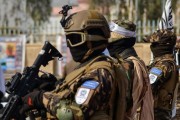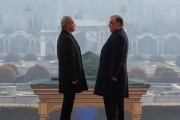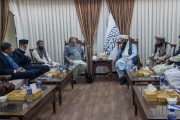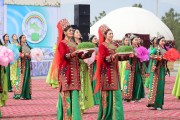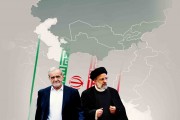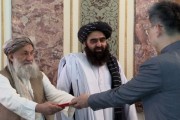Publish Date
Thursday 18 November 2021 - 12:46
recommended
0
Afghan Shias; return of Taliban and rise of ISKP
Afghanistan's Shias, who make up 12 to 20 percent of the country's population, have always failed to play a significant role in the country's equations. After the rise of ISKP (Islamic State of Khorasan Province), the Shias have been one of the terrorist group's targets, and during the Taliban’s rule, ISKP operations inflicted heavy casualties on the Shias, at least in two different attacks. Transferring Iraq’s failed project to Afghanistan with the aim of creating a religious war and spreading insecurity to the surrounding countries is now considered a potential and serious threat. Since the beginning of Taliban's rule in Afghanistan, ISKP has failed to seize any geography or sensitive population center. In general, the continuation of ISKP attacks against the Afghan Shias will strengthen the Taliban's determination to defend the Shias due to responsibility the group feels towards its people. It will also increase the solidarity and resistance of other ethnic groups against ISKP. The ISKP’s efforts to create a religious war in Afghanistan could pave the way for the regional countries’ cooperation with the Taliban as well as formation of an anti-ISKP coalition, just like what we saw in Syria and Iraq.
By: Mir Ahmad Mashal
The Shias, just like any other Islamic groups, are present all across the Islamic world. There is a Shia population in all the Islamic countries. In Afghanistan there is also a significant Shia population, but the exact number of them are not clear. In fact, the existence of a forty-year crisis has not provided the necessary opportunity for an accurate census of the country's population, especially the Shia community. However, what is particularly remarkable about the Shias in Afghanistan is their connection to the Hazara ethnic group, one of the four major ethnic groups of Afghanistan.
Despite the fact that the Hazaras make up a significant population in Afghanistan, but as mentioned earlier, due to the lack of an accurate census, the exact number of the Hazara population as well as Shias is not clear. However, some statistics show that Hazara community make up between 9 and 20 percent of Afghanistan’s population- the governmental statistics show a number between 9 and 12 percent, and some non-governmental statistics show up to 20 percent. According to ground realities of Afghanistan, however, 20 percent seems more logical. If we consider the population of the Hazaras as about 20 percent, we have almost reached to the definitive number of Shias. Given the links between the Hazaras and Shiism, the analysis that is presented here about the Hazaras can also show the status of the Shiism, the position of this sect and its followers, and the views of other ethnic groups towards this sect.
Despite the fact that a significant number of Hazaras are Sunni and a number of Pashtuns and Tajiks are Shia, this synonymy stems from the dominant mentality among the non-Hazara and non-Shia ethnic groups in Afghanistan that "each Hazara is a Shia and each Shia is a Hazara." In general, there are two big pictures regarding the position and role of Shias/Hazaras and the views of other ethnic groups/Sunnis. One of these pictures is pessimistic and the other is optimistic, each of which has its own components. In this article, we will first analyze the pessimistic components and then the optimistic ones. Moreover, we will address another different issue that has emerged since the rise of ISKP in Afghanistan.
Pessimistic components
What has created a negative mentality towards Shias/Hazaras in the minds of other religious-ethnic groups is due to several factors:
The Shias, just like any other Islamic groups, are present all across the Islamic world. There is a Shia population in all the Islamic countries. In Afghanistan there is also a significant Shia population, but the exact number of them are not clear. In fact, the existence of a forty-year crisis has not provided the necessary opportunity for an accurate census of the country's population, especially the Shia community. However, what is particularly remarkable about the Shias in Afghanistan is their connection to the Hazara ethnic group, one of the four major ethnic groups of Afghanistan.
Despite the fact that the Hazaras make up a significant population in Afghanistan, but as mentioned earlier, due to the lack of an accurate census, the exact number of the Hazara population as well as Shias is not clear. However, some statistics show that Hazara community make up between 9 and 20 percent of Afghanistan’s population- the governmental statistics show a number between 9 and 12 percent, and some non-governmental statistics show up to 20 percent. According to ground realities of Afghanistan, however, 20 percent seems more logical. If we consider the population of the Hazaras as about 20 percent, we have almost reached to the definitive number of Shias. Given the links between the Hazaras and Shiism, the analysis that is presented here about the Hazaras can also show the status of the Shiism, the position of this sect and its followers, and the views of other ethnic groups towards this sect.
Despite the fact that a significant number of Hazaras are Sunni and a number of Pashtuns and Tajiks are Shia, this synonymy stems from the dominant mentality among the non-Hazara and non-Shia ethnic groups in Afghanistan that "each Hazara is a Shia and each Shia is a Hazara." In general, there are two big pictures regarding the position and role of Shias/Hazaras and the views of other ethnic groups/Sunnis. One of these pictures is pessimistic and the other is optimistic, each of which has its own components. In this article, we will first analyze the pessimistic components and then the optimistic ones. Moreover, we will address another different issue that has emerged since the rise of ISKP in Afghanistan.
Pessimistic components
What has created a negative mentality towards Shias/Hazaras in the minds of other religious-ethnic groups is due to several factors:
Religious differences that turn into hostilities;
Distinct ethnic identity of Shias;
Definite and almost confined geography of Hazaras/Shaias which is mainly located in central regions of the country; and
Lack of a socio-political role in the contemporary history of Afghanistan.
Distinct ethnic identity of Shias;
Definite and almost confined geography of Hazaras/Shaias which is mainly located in central regions of the country; and
Lack of a socio-political role in the contemporary history of Afghanistan.
Regarding the religious differences and their transformation into hostilities, it can be said that the root of this issue is unfortunately in some stories and narratives that can be generally found in the classical religious texts of Sunnis and Shias. Although the Sunni and Shia sects do not differ in principles, the texts that have been produced on both sides over the past centuries and are being taught in the educational circles to this day, have developed the methodological and jurisprudential differences of the two sects in a way that even in some cases they have excommunicated each other. This issue, which dates back to the era of Rashidun Caliphs (the first of the four major caliphates established after the death of the Islamic prophet Muhammad), led to more division between the Sunnis and Shias in the following centuries, especially after the emergence of Takfiri movements. For this reason, in the areas with a predominantly Sunni population, the Shias have been marginalized, and vice versa.
The existing religious divisions and their widening by the informal educational circles aggravated the troubles to such an extent that even the Sunni Hazaras avoid approaching the Shia Hazaras and try not to have contact with them. The more dangerous and deadly aspect of this issue is that it can be used as the Achilles heel of these religious groups by the colonialist powers and enemies of Islam. The growth of the Takfiri groups in the last few decades, as a result of the injection of those religious texts which easily call a Muslim an infidel, is one of the approaches that can always ignite the religious war between the Muslims. This approach has been more intense in the last two decades, especially in the field of anti-Shiism and Shia-phobia.
In Afghanistan, however, these efforts, despite huge investments, have not been very fruitful in terms of fanning the flames of religious war between the Afghan tribes. Another issue that has created a somewhat ethnic and cultural division between Shias and Sunnis is the impact of the Hazara ethnicity factor. The prevailing perception of Afghanistan's history is that the land historically belongs to the Aryan tribes. Although the real origin of all the Afghan tribes have not been scientifically identified, the historical books written in Afghanistan are replete with the theory that the tribes that speak Indo-European languages today and whose appearance is non-Turco-Mongol are all descendants of the Aryans, and naturally, the land of Afghanistan belongs to them. Although there are many disagreements regarding this theory, the contemporary historiography has attempted to create a common ground between the Pashtuns and Tajiks, and draw a common racial root between them.
In this picture, the Hazaras are depicted as non-Aryan, non-native and alien. In fact, in the eyes of the majority of other ethnic groups of Afghanistan, who often call themselves Aryans, the Hazaras are thought to be a foreign ethnic group. This issue, besides the previous points, has prevented the Hazaras from socially and culturally approaching the non-Hazaras and non-Shia population, and as a result, they have been socially excluded from the Afghan society. That is why in the big cities of Afghanistan, especially Kabul, a kind of social polarization between the Hazaras and non-Hazaras has emerged and the Hazara/Shia neighborhoods with a specific address and place has been created. Meanwhile, what has led to the deepening of the social and cultural gap between the Shia Hazaras and the Sunni non-Hazaras is the geographical isolation of Hazara population.
Regardless of the reasons which have made the Hazaras/Shias to become more concentrated in the central and mountainous areas, this has led to the isolation of this community in Afghanistan. Although the whole Afghan society is somewhat fragmented and polarized, with Pashtuns congregated in certain areas and Tajiks and Uzbeks congregated elsewhere, the Hazara population is geographically more isolated than others. This situation, while preventing a demographic and socio-cultural integration, has developed different cultures and social structures over time and has led to cultural alienation between the Hazaras - as the main followers of the Shia sect – and other ethnic groups.
Another issue that has contributed to the marginalization of the Hazaras/Shias in Afghanistan is the lack of having a tangible role in the socio-political equations and developments of Afghanistan, at least in the contemporary era. Although other non-Pashtun tribes have not also played the necessary role in the socio-political equations on a large scale, the role and presence of the Hazaras has been almost zero. This issue, which is more historical and has not been changed over the last few decades, has created a nonsensical mentality among other ethnic groups that the Hazaras do not have the right to participate in the power structure, and if they have been given a share in the power, it has been a kind of favor to them.
Optimistic components
In addition to pessimistic components which are a source for deepening the religious differences between the Shias and Sunnis in Afghanistan, there are also many components and factors that can ease the religious differences between the Shias and Sunnis and create an atmosphere of friendly and fraternal interaction between them.
The first important and influential issue that acts as a deterrent factor in emergence of strife in the Afghan society is the Hanafi sect. It can be said with certainty that the Hanafi sect, due to its balanced and soft interpretation of the Islamic law and jurisprudence, prevents its followers from falling into the trap of religious strictness and confrontation with others, including the Shias. Among other good features of the Hanafi sect is that all of its followers have been warned against labeling other Muslims as Infidels, which unfortunately is very easily done in some other sects.
Because of this feature and other rules of the Hanafi sect, its followers not only do not have the right to call the Shias as infidel, but also consider the lovers and followers of Ahl al-Bayt (the holy family of the Prophet Muhammad) as respectable and believe that they have a religious right on Hanafis. In one of the official Afghan textbooks, there is a narration that Imam Abu Hanifa has been one of the students of Imam Ja'far al-Sadiq, the sixth Imam of the Shias and the founder of the Ja'fari school. Naturally, this narration would have great impact on creating a positive mentality among the followers of the Hanafi sect towards their Shia brothers, who are the followers of the sect of their Imam's master.
The second issue, which has diminished the opportunity of any religious war among Afghanistan's ethnic groups is a different issue that has been a major cause of war and conflict in Afghanistan.
The Soviet invasion of Afghanistan, not only did not pave the way for the religious war, but even led to a kind of alignment between the Afghan tribes and religions. Although the Shia and Sunni religious parties had their own foreign bases and resources, and were fighting on separate fronts inside the country against the Soviet army, they all pursued a common goal. Following the withdrawal of the Soviet Union and the outbreak of civil war in Afghanistan, the format of the war was changed from jihad against an aggressor to an ethnic conflict over power distribution. After the US invasion of Afghanistan and creation of an inclusive government without the Taliban, the nature of the differences remained ethnical and never found a religious aspect. In general, we can say the issue of ethnic conflict over power distribution in Afghanistan will never be replaced by any other forms of conflicts, especially religion ones.
In addition to this issue, there are other factors that have played an important role in reduction of religious differences in Afghanistan, and changed the Shia and Sunni mindsets. These factors include integration of the Shia and Sunni population over the last twenty years which happened due to the new developments of Afghanistan; expansion of urbanization and population integration that occurred in the large cities; emergence of open social and political space; recognition of the Ja’fari sect as one of the official sects in the Afghan constitution; expansion of academic literacy and marginalization of religious and informal literacy which led to isolation of different classic jurisprudential and religious texts; and creation of a kind of economic interdependence in the new Afghan society.
Re-emergence of Taliban and the issue of ISKP in Afghanistan
Despite the above-mentioned factors that can or have been able to reduce the religious divisions and lead the Afghan society towards an "Afghan" culture, there are still two major issues that can serve as sources of religious strife and conflict in the future. These two issues are the return of the Taliban to power and the presence of ISKP in Afghanistan. Regarding the first issue, it can be said that the Taliban, apart from what they have done in the past, today are less inclined to create a suffocating and harsh atmosphere against the Shias in Afghanistan. This can be deduced from several important reasons: The first reason is that the Taliban are Hanafis, who naturally, according to what has been explained before, are not allowed to create a strict atmosphere which can cause a negative and vengeful reaction among the Shias. Another reason is the Taliban’ new commitments to the Afghan society as well as the international community, especially the neighboring countries, including the Islamic Republic of Iran.
The Taliban have repeatedly stated, both explicitly and implicitly, that they are seeking good governance and good treatment with all the Afghan citizens, as well as good relations with other countries, especially their neighbors. Another important issue is the issue of the ISKP, which since the era of the previous government, has declared the Shias as its main target. The group is certainly pursuing a Western- Arabic project in the Middle East and Afghanistan against Shias and Iran to weaken the Shias in the region and create a conflict between the Sunnis and Shias. Although this project has almost failed in Iraq and Syria, its transfer to Afghanistan, as a war-torn country with little power to contain it, with the aim of creating a religious war and spreading insecurity to the neighboring countries, is a serious potential risk.
What can be said about Afghanistan is that ISKP, despite its efforts, has not yet been able to capture a significant geographical region or a sensitive population center. Although this danger existed during the previous government due to the war with the Taliban, now by the Taliban’s gaining power in Afghanistan, such an opportunity has been taken away from the ISKP and this group is only able to carry out suicide attacks in the civilian centers, mostly against the Shias.
In a general assessment, the continuation of ISKP attacks against the Afghan Shias will strengthen the Taliban's determination to defend the Shias. It will also increase the solidarity and resistance of other ethnic groups against ISKP. Therefore, The ISKP’s efforts to create a religious war in Afghanistan could pave the way for the regional countries’ cooperation with the Taliban as well as formation of an anti-ISKP coalition, just like what we saw in Syria and Iraq.
Mir ahmad Mashal, is a researcher at the Institute for East Strategic Studies
News code:2870






